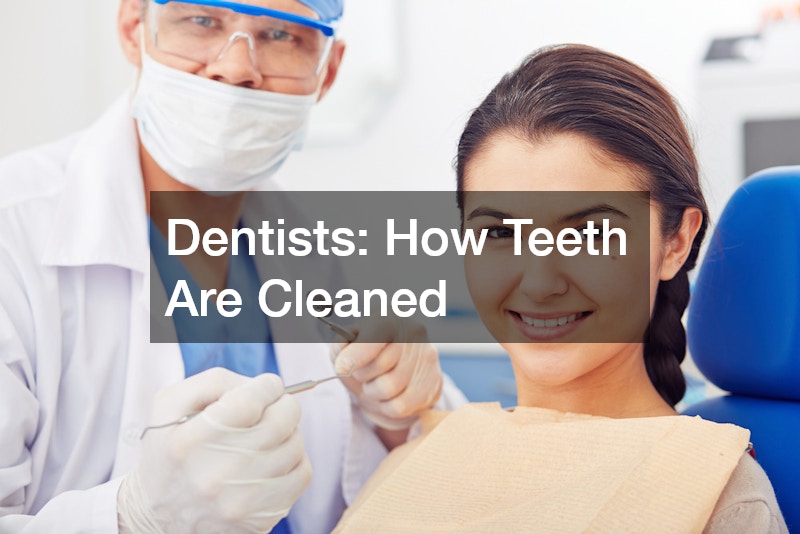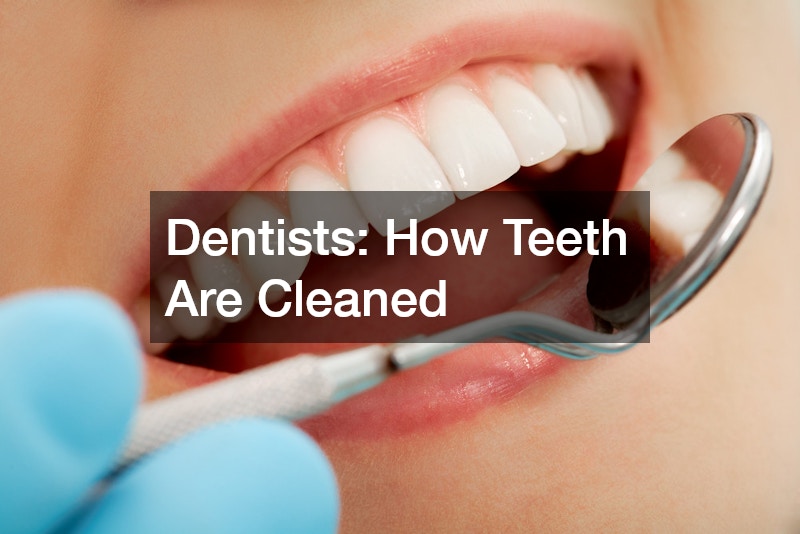
Dentists How Teeth Are Cleaned

Dentists: How Teeth Are Cleaned
Introduction
Regular dental cleanings form a fundamental part of oral health maintenance, applicable to people of all ages. Dentist in Lenoir City not only prevent dental issues but also promote overall health by catching potential problems early and provide a refreshing, confident smile. In this article, we will dive deep into the intricacies of professional dental cleaning, explore its significance, and contrast it with home cleaning methods.
We will also discuss the importance of various tools and innovations in ensuring effective dental care. By the end, you will have comprehensive insights into why scheduling regular dental cleanings is a wise investment for your health.
1. What is the Process of Professional Teeth Cleaning?
a. Initial Examination
The first step in a professional dental cleaning is the initial examination, where the dentist or dental hygienist assesses the current state of your oral health. This includes scrutinizing your teeth and gums for signs of irritation, decay, or other abnormalities. Diagnostic tools such as X-rays may be employed to look beyond what is visible to the naked eye. Catching these conditions early can help in managing them before they develop into more severe issues. Regular examinations are crucial, as some conditions may not present noticeable symptoms initially.
b. Plaque and Tartar Removal
One of the most critical components of dental cleaning is the removal of plaque and tartar. Plaque, a sticky film of bacteria, can harden into tartar if not removed regularly, leading to gum disease and decay. Dental professionals use special tools, like the scaler, to effectively scrape away these deposits from teeth surfaces and along the gum line. This process, known as scaling, is essential as tartar cannot be removed by regular brushing and flossing at home. Through professional scaling, dentists help in preventing further dental problems and maintaining oral hygiene.
c. Tooth Polishing
After the tartar removal, the next step is polishing the teeth surfaces to eliminate any stains and smooth the enamel. Dentists utilize a prophylaxis paste in conjunction with a high-powered brush that provides a thorough clean. Polished teeth not only feel smoother, which helps in reducing plaque accumulation, but also look brighter. This cosmetic benefit can boost your confidence and encourage better oral hygiene practices. Tooth polishing is a gentle, painless process that is an integral component of regular dental cleanings.
d. Flossing and Rinsing
The cleaning process also encompasses professional flossing, which ensures that any remaining plaque or debris between the teeth is removed. This part of cleaning reassures that areas missed during routine home care are adequately addressed. The professional flossing technique typically reaches those tight spots that are otherwise challenging to access. Following flossing, a thorough rinse of the mouth with a liquid solution eliminates leftover debris and leaves the mouth feeling refreshed. This step is instrumental in completing the cleaning process, providing a comprehensive oral cleanse.
e. Fluoride Treatment
The final step often involves applying a fluoride treatment to fortify the teeth. Fluoride is a mineral that greatly benefits the teeth by strengthening enamel and making it more resistant to decay. Dentists apply a concentrated fluoride gel or varnish using a small brush, and the patient is typically advised not to eat or drink for half an hour post-treatment. This allows optimal absorption, maximizing its protective benefits. Regular fluoride applications as part of dental cleanings contribute significantly to prolonged oral health and cavity prevention.
2. Why is Regular Dental Cleaning Important?
a. Prevention of Cavities
One of the foremost reasons to maintain regular dental cleanings is cavity prevention. Routine cleanings remove plaque, the leading cause of tooth decay. When left untreated, plaque converts sugars in food to detrimental acids, which can erode the tooth enamel, forming cavities. Professional cleaning mitigates this risk by effectively keeping plaque and tartar at bay. Additionally, early detection during check-ups allows for immediate action, preventing minor issues from escalating into serious damage.
b. Gum Disease Prevention
Gum disease, such as gingivitis, is directly linked to plaque and tartar build-up when oral hygiene is neglected. Regular dental cleanings aid in averting the onset and progression of gum diseases through meticulous cleaning and early detection. A professional cleaning helps to manage bacteria that cause gum inflammation and deteriorate gum tissues. As gum disease progresses, it can result in tooth loss; however, maintaining regular cleanings and professional advice can prevent such outcomes. Optimal gum health directly reflects the benefits of consistent dental cleanings.
c. Freshening Breath
Persistent bad breath, or halitosis, is often an indicator of poor oral hygiene. Regular dental cleanings provide a thorough cleanse that significantly helps in keeping breath fresh. By eliminating food particles and bacteria, along with deep flossing and professional-grade toothpaste, dental cleanings tackle the root causes of halitosis. A fresh and pleasant breath can greatly enhance your self-confidence in daily interaction. Professional dental cleanings play a key role in maintaining oral freshness and health.
d. Boosting Overall Health
The connection between oral health and overall physical health is increasingly recognized by medical professionals. Poor oral hygiene is linked to various conditions like cardiovascular disease, diabetes, and respiratory infections. Regular dental cleanings contribute to overall health by averting dental infections that might spread systemically. This preventive approach to oral care underscores the adage, “The mouth is the gateway to the body.” Considering systemic wellbeing, regular cleanings foster a healthier lifestyle.
e. Cost Efficiency in Long Term Dental Care
While dental cleanings require an initial investment of time and resources, they prove cost-efficient in the long term. Preventive care through regular cleanings saves you money by avoiding complex and expensive treatments resulting from neglected oral health. Identifying potential issues early means that less invasive and affordable treatments can be administered promptly. By staying diligent with dental cleanings, you effectively mitigate the risks of needing more costly procedures. Ultimately, regular dental visits conserve both finances and health.
3. How Often Should You Get Your Teeth Cleaned?
a. General Recommendations
The general recommendation for dental cleaning frequency is traditionally every six months. This timeframe suffices for most individuals in removing plaque build-up and maintaining dental health. However, this recommendation may vary based on the patient’s unique circumstances and oral health status. Dentists can tailor the cleaning schedule based on individual assessments to optimize oral health outcomes. It’s advisable to consult with your dentist to determine the most appropriate cleaning frequency for you.
b. Factors Affecting Cleaning Frequency
Several factors play a role in determining how often you should have your teeth professionally cleaned. Diet, lifestyle, and individual oral hygiene practices can affect your need for more frequent cleanings. High sugar intake, smoking, and pre-existing dental conditions may necessitate increased cleaning intervals. Personal health status can also influence frequency recommendations, including conditions such as diabetes, which may increase susceptibility to gum diseases. Personalizing cleaning schedules enhances the effectiveness of dental care.
c. Signs You Need More Frequent Cleanings
Certain signs indicate a potential need for more frequent dental cleanings. Persistent bad breath, gum bleeding, or swollen gums suggest oral health might be compromised, requiring extra attention. Frequent tooth pain or sensitivity may also be a symptom of underlying issues that need professional intervention. Regular evaluations and consultations with your dentist enable prompt actions in response to such symptoms. Recognizing and acting upon these signs ensures your oral health is not compromised.
d. Differences for People with Orthodontics
Individuals undergoing orthodontic treatment, such as braces or aligners, have unique dental cleaning needs. Orthodontic appliances can trap food and plaque more easily, necessitating more frequent cleanings to prevent decay and gum disease. Dentists recommend additional professional attention and tailored cleaning methods to accommodate these specific challenges. Extra caution and care are vital to ensure orthodontic treatment doesn’t negatively impact oral health. Regular cleanings significantly aid in maintaining hygiene while achieving orthodontic goals.
e. Advice from Dental Professionals
Dentists and dental hygienists are invaluable resources for personalized advice on optimal dental cleaning frequency. They assess your oral health and offer recommendations tailored to your dental needs. Encouraging regular interaction with dental professionals ensures potential issues are monitored and managed effectively. Personalized guidance from professionals can empower individuals to make informed decisions about their oral care. Building a positive relationship with dental care providers is key to achieving and maintaining optimal oral health.
4. What Tools and Techniques are Used in Dental Cleaning?
a. Manual vs. Ultrasonic Scalers
Dental professionals employ both manual and ultrasonic scalers to remove plaque and tartar during cleanings. Manual scalers require precision handcraft, skilfully removing deposits through tactile feedback. Ultrasonic scalers, on the other hand, utilize vibrations to dislodge tartar, making removal effective yet gentle. Both tools have their benefits, with dentists choosing the best method based on patient needs and conditions. Their effective use ensures thorough cleaning, promoting healthy gum and tooth surfaces.
b. Polishing Tools and Pastes
Tooth polishing involves specialized tools like prophylaxis cups and brushes that efficiently spread polishing agents on tooth surfaces. These tools often pair with flavored pastes, which remove stains and impart a smooth, glossy finish to teeth. They also reduce surface roughness, thereby discouraging future plaque build-up through glide and precision. Dental hygienists select polishing pastes designed for specific patient needs, such as sensitive teeth. Together, these tools and pastes ensure an optimal tooth polish, significantly enhancing appearance and cleanliness.
c. Fluoride Application Instruments
Dentists employ precise instruments to administer fluoride treatments effectively. Gel or varnish forms of fluoride typically offer high concentration for potent remineralization and protection. Application instruments ensure uniform distribution over teeth, maximizing the protective benefits of fluoride. Dentists provide post-treatment guidelines, like abstaining from food and drink, to enhance fluoride effectiveness. Consistent application of fluoride significantly boosts overall dental health and cavity prevention.
d. Sterilization and Hygiene Practices
Hygiene and sterilization practices in dental clinics are pivotal to ensuring patient safety and care. Dental instruments undergo rigorous sterilization processes, utilizing autoclaves and chemical disinfectants to eliminate any potential contaminants. Clinics implement strict hygiene protocols to create a safe environment for both patients and dental practitioners. Regular training and adherence to best practices maintain the highest standards of hygiene. Ensuring a sanitary dental visit is integral to delivering safe and effective treatments.
e. Innovations in Dental Cleaning
The field of dental cleaning is witnessing continuous innovations that enhance treatment outcomes and patient comfort. Technologies such as laser dentistry, air polishing systems, and digital imaging are elevating cleaning efficiency and precision. Laser technology offers minimal invasive cleaning with reduced discomfort, while air polishing provides rapid stain removal. Digital imaging grants practitioners immediate clarity, streamlining diagnosis and planning. These innovations exemplify transformation and enhancement in dental services, promising improved patient experiences and results.
5. Can You Achieve the Same Results with Home Teeth Cleaning?
a. Differences Between Home and Professional Cleaning
Home teeth cleaning practices, though essential for daily oral hygiene, cannot wholly replace professional cleanings. Home care tools like toothbrushes and floss lack the capability of deep cleaning achieved during professional visits. Unlike home routines, dental clinics utilize specialized equipment to address plaque and tartar build-up comprehensively. Neglecting professional cleanings allows oral health issues to progress unnoticed, compromising oral wellness. Consequently, both home and professional care are indispensable to attaining optimal dental health.
b. Effective Home Tools and Products
Maintaining dental hygiene at home is crucial, necessitating the use of effective tools and products. Electric toothbrushes, floss picks, and interdental brushes can enhance cleaning efficiency by reaching difficult areas and ensuring thorough plaque removal. Mouth rinses with antibacterial properties add an extra layer of protection against bacteria growth. Using fluoridated toothpaste fortifies enamel, mirroring protective benefits from professional fluoride treatments. A balanced combination of these products supports ongoing oral health between pro visits.
c. Techniques for Effective Home Cleaning
Implementing proper techniques is key to maximizing the effectiveness of home teeth cleaning. Brushing twice daily, for two minutes each time, ensures comprehensive cleaning across all tooth surfaces. Proper flossing techniques, using a gentle sawing motion, efficiently remove plaque from between teeth. Incorporating mouth rinses as a final rinse helps in eradicating remnant bacteria, imparting a lasting fresh feeling. Adherence to these techniques reinforces daily care routines, safeguarding oral health. They establish a solid foundation for oral hygiene between dentist appointments.
d. The Limitations of Home Cleaning
Relying solely on home dental cleaning has inherent limitations. Home care cannot remove hardened tartar nor provide an adequate examination for early dental issues. Only trained professionals can detect and address these issues to prevent more severe complications. Furthermore, specialized dental equipment is required to clean thoroughly without causing harm, which is unavailable at home. Recognizing these limitations illustrates the need for professional cleanings alongside home regimens to comprehensively manage oral health.
e. Reinforcement of Professional Visits
Regular professional visits are integral even in the face of diligent home dental care. While daily home practices can mitigate oral issues, professional cleaning ensures comprehensive care that home routines cannot fulfill. Engaging dental professionals consistently reinforces efforts made at home, preventing the progression of hidden dental problems. A symbiotic relationship between home care and professional appointments maximizes oral health benefits. Scheduling regular dental checkups is invaluable in maintaining a healthy, confident smile.
Conclusion
In conclusion, regular professional dental cleanings are a vital aspect of maintaining overall oral health and preventing various dental conditions. The professional expertise and equipment used during these visits facilitate a level of cleaning and preventive care that home care simply cannot match. By understanding the detailed processes, tools, and techniques involved in dental cleaning, individuals can better appreciate its significance and make informed decisions about their oral care routines. A balanced approach involving both home practices and regular professional visits ensures comprehensive dental health, contributing to a healthier lifestyle. Prioritizing oral health through regular cleanings is a proactive step toward long-term wellbeing.



